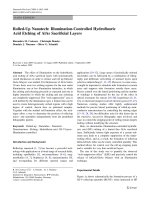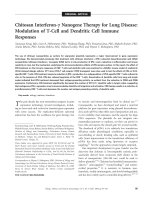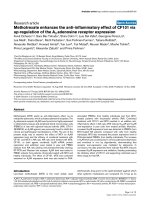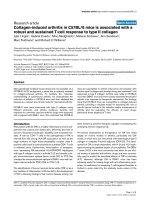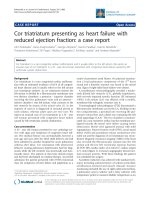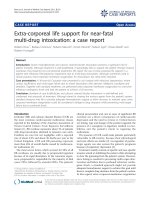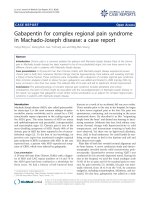Báo cáo y học: "Turning up the volume on mutational pressure: Is more of a good thing always better? (A case study of HIV-1 Vif and APOBEC3)" pot
Bạn đang xem bản rút gọn của tài liệu. Xem và tải ngay bản đầy đủ của tài liệu tại đây (1.1 MB, 8 trang )
BioMed Central
Page 1 of 8
(page number not for citation purposes)
Retrovirology
Open Access
Commentary
Turning up the volume on mutational pressure: Is more of a good
thing always better? (A case study of HIV-1 Vif and APOBEC3)
Satish K Pillai*
1,2
, Joseph K Wong
1,2
and Jason D Barbour
1
Address:
1
Department of Medicine, University of California, San Francisco, CA 94121, USA and
2
Veterans Affairs Medical Center, San Francisco,
CA 94121, USA
Email: Satish K Pillai* - ; Joseph K Wong - ; Jason D Barbour -
* Corresponding author
Abstract
APOBEC3G and APOBEC3F are human cytidine deaminases that serve as innate antiviral defense
mechanisms primarily by introducing C-to-U changes in the minus strand DNA of retroviruses
during replication (resulting in G-to-A mutations in the genomic sense strand sequence). The HIV-
1 Vif protein counteracts this defense by promoting the proteolytic degradation of APOBEC3G and
APOBEC3F in the host cell. In the absence of Vif expression, APOBEC3 is incorporated into HIV-
1 virions and the viral genome undergoes extensive G-to-A mutation, or "hypermutation", typically
rendering it non-viable within a single replicative cycle. Consequently, Vif is emerging as an
attractive target for pharmacological intervention and therapeutic vaccination. Although a highly
effective Vif inhibitor may result in mutational meltdown of the viral quasispecies, a partially
effective Vif inhibitor may accelerate the evolution of drug resistance and immune escape due to
the codon structure and recombinogenic nature of HIV-1. This hypothesis rests on two principal
assumptions which are supported by experimental evidence: a) there is a dose response between
intracellular APOBEC concentration and degree of viral hypermutation, and, b) HIV-1 can tolerate
an elevated mutation rate, and a true error or extinction threshold is as yet undetermined.
Rigorous testing of this hypothesis will have timely and critical implications for the therapeutic
management of HIV/AIDS, and delve into the complexities underlying the induction of lethal
mutagenesis in a viral pathogen.
Commentary
The evolutionary potential of HIV-1 is unquestionably
one of the key factors underlying its extreme resilience in
the face of host immunity and antiretroviral drug pres-
sure. RNA viruses in general have high mutation rates, and
HIV-1 is not an exception with an estimated rate of 3.4 ×
10
-5
mutations/site/generation, owing to the poor fidelity
of reverse transcriptase and a lack of proofreading
machinery [1]. In addition, recombination is rampant
within HIV populations, and several reports suggest that it
may be an even more powerful force in shaping HIV evo-
lutionary patterns than mutation. Rates approaching 10
crossovers per replication cycle have been observed within
in vitro systems [2]. The true magnitude of these evolu-
tionary processes becomes apparent when discussed in
the context of HIV population biology. Stochastic models
suggest that 10
10
viral particles are produced each day
within an infected individual, and generation time is in
the neighborhood of 1.8 days [3]. This rate of production
and turnover coupled with the aforementioned rates of
recombination and mutation allow the virus to explore
vast reaches of sequence space in short periods of time.
Published: 13 March 2008
Retrovirology 2008, 5:26 doi:10.1186/1742-4690-5-26
Received: 13 October 2007
Accepted: 13 March 2008
This article is available from: />© 2008 Pillai et al; licensee BioMed Central Ltd.
This is an Open Access article distributed under the terms of the Creative Commons Attribution License ( />),
which permits unrestricted use, distribution, and reproduction in any medium, provided the original work is properly cited.
Retrovirology 2008, 5:26 />Page 2 of 8
(page number not for citation purposes)
The evolutionary wizardry of HIV-1 comes at a substantial
cost to the virus. The majority of viral particles are
believed to be non-infectious due to genetic anomalies
and assembly defects, reflecting the haphazard nature of
the replication process [4]. Multiple reports suggest that
the HIV-1 proviral DNA population in infected individu-
als is primarily composed of heavily mutated, replication
incompetent genomes [5,6]. The mutation rate of HIV-1
may in fact walk a very narrow line between requisite
evolvability (to avoid annihilation in a highly dynamic
and treacherous environment) and requisite fidelity (to
avoid population collapse resulting from a surfeit of dele-
terious mutations). Therefore, it has been hypothesized
that even a marginal increase in the mutation rate of HIV-
1 will result in genetic meltdown of the viral quasispecies,
a phenomenon known as "error catastrophe" [7,8]. The
induction of error catastrophe as an antiviral strategy has
been explored extensively in the laboratory, but as of yet,
this "lethal mutagenesis" approach has not been utilized
in a clinical setting to manage HIV infection [9,10]. The
treatment of chronic hepatitis C virus (HCV) infection
with the ribonucleoside ribavirin may be an example of
lethal mutagenesis [11], although the extensively charac-
terized immunomodulatory activity of ribavirin suggests
that non-mutagenic mechanisms likely contribute to its
antiviral potency [12]. Nevertheless, there is an undenia-
ble musicality associated with transforming the virus'
greatest strength into its Achilles heel, and there is a pro-
nounced need for novel therapeutic strategies due to
resistance and toxicity issues surrounding existing antiret-
roviral agents.
A recent major development in the HIV research world
involving an endogenous host-encoded mutagen has
brought the concept of lethal mutagenesis to center stage.
Apolipoprotein B mRNA editing enzyme, catalytic
polypeptide-like 3G (APOBEC3G) was found to serve as
an innate antiviral defense mechanism by introducing C-
to-U changes in the minus strand DNA of retroviruses dur-
ing replication (resulting in G-to-A mutations in the
genomic sense strand sequence) [13]. Soon thereafter,
surveys of the entire APOBEC cytidine deaminase family
revealed that another member, APOBEC3F, exhibits simi-
lar antiviral potency and cDNA editing capacities [14].
The HIV-1 genome, however, encodes the 23 kilodalton
protein Vif (virion infectivity factor) which specifically
counteracts this defense by promoting the proteolytic deg-
radation of APOBEC3G and APOBEC3F in the host cell
(and perhaps by inhibiting the translation of these host
factors as well) [15-17]. In the absence of Vif expression,
APOBEC3 is incorporated into virions and the viral
genome undergoes extensive G-to-A mutation, or "hyper-
mutation", typically rendering it non-viable within a sin-
gle replicative cycle. Consequently, Vif is emerging as an
attractive target for pharmacological intervention and
therapeutic vaccination [18-21].
Our experience with current antiretrovirals suggests that a
Vif antagonist will most likely be less than 100% effective
at suppressing Vif activity, due to pharmacokinetic limita-
tions, the presence of anatomic compartments with poor
drug penetration characteristics (e.g. central nervous sys-
tem), and the seemingly inevitable evolution of partial
drug resistance [22]. Therefore, the possibility exists that
incomplete Vif suppression will elevate intracellular
APOBEC3 concentrations just enough to exert an interme-
diate (sub-error catastrophe) level of mutational pressure
on the HIV-1 genome, accelerating viral evolution with-
out inducing population collapse (Fig. 1). This scenario is
supported by features of the HIV-APOBEC3 interaction
which have been elucidated by careful and detailed exper-
imental work:
There is a dose response between intracellular APOBEC
concentrations and degree of viral hypermutation
Based on data from in vitro cytidine deaminase assays, the
extent of hypermutation (average number of G-to-A
mutations per target sequence) is directly proportional to
cellular APOBEC3G concentration [23]. If hypermutation
was an all-or-nothing binary phenomenon, and APOBEC
levels were only correlated with the overall number of
viral genomes that were subject to hypermutation, there
would be little cause for concern. However, experimental
data demonstrate convincingly that both the overall
number of sequences and the number of deaminated sites
within each sequence scale with APOBEC concentration.
Analysis of HIV-1 sequence data from infected individuals
provides additional circumstantial evidence of an
APOBEC dose effect. Complete genome sequences
labeled as "hypermutants" (a designation which is rather
arbitrary at this point) in the Los Alamos HIV Database
vary quite dramatically in apparent levels of G-to-A substi-
tution, both between and within viruses [24]. Some
hypermutants are littered with canonical APOBEC-
induced mutations and appear to be evolutionary dead
ends, while others are barely distinguishable from non-
hypermutant control sequences and may in fact represent
replication competent viruses. The APOBEC dose effect is
also apparent within each individual hypermutant
sequence; there is a pronounced 5' to 3' mutational gradi-
ent, reflecting the length of time that the single-stranded
DNA intermediate is exposed and accessible to deaminase
activity during the reverse transcription process [24,25].
These observations are complemented and reinforced by
the apparent stoichiometry of APOBEC3G in virions.
Each delta-vif virion is believed to incorporate between
3–11 molecules of APOBEC3G [26], dependent on the
presence of viral genomic RNA in the forming virion [27],
and varying in tandem with intracellular concentrations
Retrovirology 2008, 5:26 />Page 3 of 8
(page number not for citation purposes)
of APOBEC3G in the producer cell [26]. Multiple reports
demonstrate that APOBEC3G is catalytically active and
has antiviral potency as a monomer. The monomeric
capacity of APOBEC3G makes the range of 3–11 mole-
cules per virion meaningful, and likely consequential
[28,29].
HIV-1 can tolerate an elevated mutation rate, and a true
upper limit (error or extinction threshold) is as yet
undetermined
Ample evidence suggests that HIV-1 populations may be
able to withstand substantial increases in mutation rate
without experiencing complete genetic meltdown. For
example, AZT and 3TC treatment, as well as the mutations
in reverse transcriptase that confer resistance to AZT,
increase the HIV-1 error rate in vivo by several-fold with-
out extinguishing the virus in the near-term. Replication
of AZT-resistant viruses in vitro in the presence of agents
like hydroxyurea and thymidine that create imbalances in
deoxynucleoside triphosphate (dNTP) pools similarly
increases mutation rate without destroying viability [30].
Although numerous mutagenesis studies describe signifi-
cant decreases in viral fitness, titre, or infectivity as a result
of mutational burden, it is unclear if these data legiti-
mately embody the precise mathematical prerequisites of
impending error catastrophe [8,10,31,32]. More impor-
tantly, extinction – that is, a detectable end to HIV replica-
tion – is rarely reported as an outcome of these
experiments.
Incomplete Vif inhibition and the resulting enhancement
of APOBEC3-mediated mutational pressure on the HIV-1
genome may accelerate evolution of antiretroviral resist-
ance [33], immune escape, and cellular tropism (corecep-
tor usage phenotype). We can initially estimate the
likelihood of these outcomes by considering the codon
structure of HIV-1 and the distribution of APOBEC3G and
APOBEC3F target sequence motifs across the HIV-1 pro-
teome. APOBEC3G and APOBEC3F principally target
"GG" (GG->AG) and "GA" (GA->AA) dinucleotides,
respectively [25,34]. Let us consider the HIV-1 subtype B
Protease consensus sequence as an example (Fig. 2). 35 of
the 99 amino acids in Protease are typically encoded by
codons that contain one or both of these dinucleotide tar-
Potential consequences of a hypothetical HIV-1 Vif-based interventionFigure 1
Potential consequences of a hypothetical HIV-1 Vif-based intervention. A highly potent Vif antagonist should signifi-
cantly elevate intracellular concentrations of APOBEC3, inducing the desired end goal of viral error catastrophe (red zone). A
moderately effective Vif inhibitor may fail to induce mutational meltdown and instead accelerate evolution of drug resistance,
immune escape, and coreceptor phenotype (yellow zone). A weak inhibitor should invoke a level of mutational pressure that
falls into the range of natural variation resulting from genetic polymorphisms in Vif and the APOBEC3 loci (green zone).
Retrovirology 2008, 5:26 />Page 4 of 8
(page number not for citation purposes)
get motifs. Of these 35 APOBEC3-susceptible amino
acids, 19 are contained within recognized cytotoxic T cell
(CTL) epitope sequences, and 10 are sites involved in
resistance against protease inhibitor drugs [35]. Even
when focusing on the frequency and distribution of
APOBEC3 target motifs within a single HIV-1 protein, it is
readily apparent that a partial Vif phenotype is likely to
modulate viral susceptibility to host immunity and drug
pressure.
We extended our thought experiment on Protease by per-
forming an in silico exercise to investigate the relationship
between enhanced APOBEC3-mediated mutational pres-
sure and evolution of antiviral resistance. We imple-
mented forward simulations of HIV-1 pol evolution under
varying APOBEC3-induced mutation rates (coded in SAS
version 9.1), focusing on the emergence of amino acid
replacements at established protease inhibitor resistance
sites [35]. Simulations were seeded with 10,000 copies of
an HIV-1 consensus B pol sequence derived from all avail-
able subtype B data in the Los Alamos Database. Back-
ground evolution and diversification was modeled by
applying a base mutation rate of 3.4*10
-5
substitutions/
site/cycle [1] to a full 12-term substitution rate matrix
Potential targets of APOBEC3G and APOBEC3F cytidine deaminase activity within HIV-1 proteaseFigure 2
Potential targets of APOBEC3G and APOBEC3F cytidine deaminase activity within HIV-1 protease. Positions
highlighted in blue, yellow, and green are encoded by codons that are targets of APOBEC3G, APOBEC3F, and both factors,
respectively. Red stars indicate targeted positions involved in antiretroviral resistance [35]. Recognized CTL epitopes and the
HLA alleles that are believed to target these regions are listed (based on prediction algorithms and/or direct experimental val-
idation, as presented in the HIV Molecular Immunology Database [40]).
Retrovirology 2008, 5:26 />Page 5 of 8
(page number not for citation purposes)
inferred from a phylogeny of intrapatient pol sequences.
APOBEC3G and APOBEC3F target dinucleotide motifs
were mutated randomly each cycle at rates from 0.0001 to
0.05 (GG -> AG, GA -> AA). Sequences with premature
stop codons were removed from the population at the end
of each generation. Simulations were allowed to run up to
200 generations (approximately 1 year assuming an HIV-
1 generation time of ~1.8 days) or until natural extinction
due to depletion of viable sequences.
Rates of population extinction in our simulations varied
tremendously between and even within APOBEC3 muta-
tion rates, due to the stochastic distribution of mutations
across sites and the fact that only one single codon
("TGG") at position 42 of the protease sequence is con-
verted to a stop codon by APOBEC3 editing. Protease
inhibitor resistance mutations were observed most fre-
quently when APOBEC3G and APOBEC3F dinucleotide
target motifs were mutated at rates of 0.001 to 0.01. Below
a rate of 0.001, mutational patterns essentially reflected
the background evolutionary model, and above 0.01,
populations tended to collapse rapidly due to the accrual
of stop codons. These results probably underestimate the
potential for APOBEC-driven resistance evolution, due to
the absence of recombination and drug-mediated positive
selection pressure in our model [36-38]. Recombination
should increase the sustainability of heavily mutated pop-
ulations by providing a means of purging stop codons and
escaping the irreversible accumulation of deleterious
mutations associated with asexual reproduction known as
Muller's ratchet [39]. Emulation of the selective environ-
ment associated with drug treatment (accounting for the
selective advantage conferred by Protease inhibitor resist-
ance mutations) would favor the maintenance and fixa-
tion of polymorphisms that reduce drug susceptibility.
Nonetheless, this reductionist modeling exercise rein-
forces the notion that a highly effective Vif inhibitor may
result in mutational meltdown or extinction of the HIV-1
quasispecies, while a weaker inhibitor may accelerate evo-
lution of drug resistance and other undesirable viral phe-
notypic characteristics.
The results of our simulation are mirrored in naturally
occurring HIV-1 protease sequences in the Los Alamos
Database [40]. A survey of all available patient-derived
subtype B protease sequences from documented hyper-
mutant genomes demonstrates that mutations at recog-
nized protease inhibitor resistance positions are
ubiquitous (Fig. 3). Nearly all of the hypermutant pro-
tease sequences have multiple non-synonymous muta-
tions at resistance codons, all of which result from G-to-A
substitutions (many of these amino acid replacements are
not typically associated with resistance, but variation at
these sites may impact mutational pathways and modu-
late viral susceptibility to antiretroviral agents to some
degree). Several of the severely hypermutated sequences,
however, contain a single premature stop codon at posi-
tion 42 and most likely represent non-functional proteins.
Such non-functional gene variants in the proviral popula-
tion may still contribute to the mean fitness and stability
of the HIV-1 quasispecies by serving as a repository of
genetic information, available for future recombination
with replication competent genomes. The array of
observed nucleotide mutations confirms earlier observa-
tions that hypermutants exhibit a wide range of APOBEC3
editing intensities [24,41]; a few of the hypermutant
genomes contain zero G-to-A substitutions in protease,
while others have up to fifty (~75% of available G's
mutated to A). Certain positions tend to be targeted across
genomes and may represent previously described muta-
tional "hotspots", where upstream nucleotides at the -1
and -2 positions favor cytidine deaminase activity [25].
Interestingly, some sequences appear to be mainly
affected by APOBEC3F deaminase activity (cyan hash
marks), while others are principally targeted and edited by
APOBEC3G (red marks), suggesting that these mutational
pressures vary independently in nature. These data dem-
onstrate that moderately hypermutated sequences that
have been subjected to intermediate levels of APOBEC3
pressure exist naturally, and moreover, these sequences
often possess multiple mutations of pharmacological and
immunological significance. An additional summary of
observed APOBEC3-induced mutations at recognized
resistance sites in HIV-1 reverse transcriptase is provided
in Table 1.
Perhaps the most provocative empirical evidence that the
HIV-1 quasispecies may benefit from enhanced APOBEC-
mediated mutational pressure is the prevalence of natu-
rally occurring partially defective Vif variants. Patient-
derived Vif variants are frequently deficient in their abili-
ties to neutralize APOBEC3G and/or APOBEC3F, and
viral sequences from these individuals exhibit mutational
profiles that are consistent with their respective suscepti-
bilities to these host factors [41,42]. Many of the observed
Vif mutations affecting function are themselves the result
of G-to-A transitions within canonical APOBEC3 dinucle-
otide motifs, suggestive of a feedback loop between Vif
sequence and APOBEC3 editing [42]. The overall highly
adenine-biased base composition and codon usage of
HIV-1 may in fact reflect adaptation to APOBEC-mediated
mutational pressure [25]. These observations are comple-
mented by population-level analyses of APOBEC3 expres-
sion and an unexpected detail regarding a natural
polymorphism in the APOBEC3G locus. There does not
appear to be any correlation between levels of APOBEC3
expression (mRNA) in peripheral blood mononuclear
cells and HIV viral loads or CD4+ counts in untreated
HIV-infected individuals [43], although a more rigorous
study design may be required to adequately address this
Retrovirology 2008, 5:26 />Page 6 of 8
(page number not for citation purposes)
relationship [44]. The H186R APOBEC3G allelic variant is
associated with accelerated HIV disease progression, and
actually appears to have slightly increased antiviral
potency based on in vitro infectivity data (cytidine deami-
nase activity was not directly measured) [45]. Taken
together, these data strongly suggest that the HIV-1 quasis-
pecies conveniently exploits APOBEC3G and APOBEC3F
as engines of genetic diversification. The virus essentially
uses Vif sequence as a volume knob to modulate its sus-
ceptibility to cytidine deaminase activity in the host, anal-
ogous to the role of mutator alleles in bacterial
populations.
In conclusion, given the dim prospects for an HIV vaccine
in the near future [46], complete or near complete neu-
tralization of Vif activity is a promising therapeutic strat-
egy that may provide a much-needed alternative to
existing treatment options. However, there are clues scat-
Mutational spectra of subtype B patient-derived hypermutant HIV-1 protease sequencesFigure 3
Mutational spectra of subtype B patient-derived hypermutant HIV-1 protease sequences. All available subtype B
protease sequences in the Los Alamos Database are included, excluding experimentally generated hypermutants. When multi-
ple identical hypermutant sequences were cataloged for a given individual, a single representative is included. Mutations occur-
ring at recognized protease inhibitor resistance positions are listed, based on Stanford HIV Drug Resistance Database
conventions [51]. Class IV mutations are listed separately, and typically need to be coupled with other mutations to contribute
to resistance. The right panel displays all mutations in each sequence with respect to the subtype B protease consensus
sequence (generated using Hypermut [40]); red = GG -> AG (APOBEC3G pattern), cyan = GA -> AA (APOBEC3F pattern),
green = GC -> AC, magenta = GT -> AT, black = all other mutations, yellow = deletion.
Retrovirology 2008, 5:26 />Page 7 of 8
(page number not for citation purposes)
tered throughout the literature that therapeutic strategies
targeting the Vif-APOBEC interaction may benefit virus
rather than host, and therefore should not be executed
without the greatest of caution and forethought. Inadvert-
ent effects of partial Vif inhibition could include the
development of drug resistance to other members of an
antiretroviral regimen, or loss of immune control due to
accelerated evolution of epitope escape mutations. The
potential outcome of a Vif-based intervention should be
examined systematically and rigorously in vitro and in sil-
ico prior to clinical deployment. Long-term serial passag-
ing of HIV-1 in the presence of scaled APOBEC3
concentrations using variable population sizes, cellular
activation states, and environmental challenges (e.g. drug
exposure) should yield invaluable insight into the likeli-
hood of treatment success. In addition, the effects of a Vif-
based intervention should be explored virtually by imple-
menting a sophisticated simulation that incorporates
recombination, positive selection, and realistic popula-
tion dynamics into the underlying model. On a different
note, there are emerging subtleties and complexities asso-
ciated with the HIV-APOBEC3 relationship that may open
up additional avenues for therapeutic intervention that
fall outside of the lethal mutagenesis realm. Antiviral
potency has recently been attributed to both APOBEC3G
and APOBEC3F that is distinct and separable from cyti-
dine deaminase activity [47-49], although the legitimacy
of this capacity is still a topic of debate [50]. A therapeutic
scheme that selectively amplifies this non-mutagenic anti-
viral phenotype without enhancing cytidine deamination
may be an effective alternate route to suppression of viral
replication.
Authors' contributions
SKP wrote the paper, conducted background research, and
performed HIV sequence analysis. JKW contributed to
writing and editing. JDB programmed the evolutionary
simulations and contributed to writing and editing.
Acknowledgements
We wish to thank Drs. John Huelsenbeck and Bill Bruno for helpful discus-
sion and Drs. Carla Kuiken and Brian Foley for technical assistance. This
work was supported by grants R01 NS51132 (S.K.P. and J.K.W.), VA Merit
Award (J.K.W.), and AI066917 (J.D.B.).
References
1. Mansky LM, Temin HM: Lower in vivo mutation rate of human
immunodeficiency virus type 1 than that predicted from the
fidelity of purified reverse transcriptase. Journal of Virology 1995,
69:5087-5094.
2. Levy DN, Aldrovandi GM, Kutsch O, Shaw GM: Dynamics of HIV-
1 recombination in its natural target cells. Proc Natl Acad Sci U
S A 2004, 101(12):4204-4209.
3. Perelson AS, Neumann AU, Markowitz M, Leonard JM, Ho DD: HIV-
1 dynamics in vivo: virion clearance rate, infected cell life-
time, and viral generation time. Science 1996, 271:1582-1586.
4. Bourinbaiar AS: The ratio of defective HIV-1 particles to repli-
cation-competent infectious virions. Acta Virol 1994,
38(1):59-61.
5. Li Y, Hui H, Burgess CJ, Price RW, Sharp PM, Hahn BH, Shaw GM:
Complete nucleotide sequence, genome organization, and
biological properties of human immunodeficiency virus type
1 in vivo: evidence for limited defectiveness and complemen-
tation. Journal of Virology 1992, 66:6587-6600.
6. Sanchez G, Xu X, Chermann JC, Hirsch I: Accumulation of defec-
tive viral genomes in peripheral blood mononuclear cells fo
HIV infected individuals. Journal of Virology 1997, 71:2233-2240.
7. Eigen M: Selforganization of matter and the evolution of bio-
logical macromolecules. Naturwissenschaften 1971,
58(10):465-523.
8. Eigen M: Error catastrophe and antiviral strategy. Proc Natl
Acad Sci U S A 2002, 99(21):13374-13376.
9. Loeb LA, Essigmann JM, Kazazi F, Zhang J, Rose KD, Mullins JI: Lethal
mutagenesis of HIV with mutagenic nucleoside analogs. Proc
Natl Acad Sci U S A 1999, 96(4):1492-1497.
10. Smith RA, Loeb LA, Preston BD: Lethal mutagenesis of HIV. Virus
Res 2005, 107(2):215-228.
11. Crotty S, Maag D, Arnold JJ, Zhong W, Lau JY, Hong Z, Andino R,
Cameron CE:
The broad-spectrum antiviral ribonucleoside
ribavirin is an RNA virus mutagen. Nat Med 2000,
6(12):1375-1379.
12. Lau JY, Tam RC, Liang TJ, Hong Z: Mechanism of action of riba-
virin in the combination treatment of chronic HCV infec-
tion. Hepatology 2002, 35(5):1002-1009.
Table 1: Observed APOBEC3-induced mutations at recognized HIV-1 RT resistance sites
a
HIV-1 RT Resistance
Position
Wildtype Codon APOBEC3G Target APOBEC3F Target Observed Mutant
Codon
Mutant Frequency
M41 [NRTI] ATG(G) + - ATA 0.7
D67 [NRTI] GAC - + na 0
Q151 [NRTI] CAG(G) + - CAA× 0.5
M184 [NRTI] ATG(G) + - ATA* 0.6
L210 [NRTI] TTG(A) - + TTA× 0.1
E138 [NNRTI] GAG(A) - + AAG* 0.3
G190 [NNRTI] GGA + + AGA 0.5
M230 [NNRTI] ATG(G) + - ATA 0.7
a
All available hypermutant HIV-1 subtype B reverse transcriptase sequences in the Los Alamos HIV Sequence Database [40] were analyzed (1
sequence sampled per individual, 10 total). Listed resistance positions are potential targets of APOBEC3G and/or APOBEC3F. Class of
antiretroviral resistance listed in brackets (NRTI = nucleoside RT inhibitor, NNRTI = non-nucleoside RT inhibitor) [51]. Nucleotides in parentheses
are immediately downstream of codons involved in antiretroviral resistance, and are included in the APOBEC3 dinucleotide target motifs. x =
synonymous (silent) mutation, * = canonical resistance codon.
Publish with BioMed Central and every
scientist can read your work free of charge
"BioMed Central will be the most significant development for
disseminating the results of biomedical research in our lifetime."
Sir Paul Nurse, Cancer Research UK
Your research papers will be:
available free of charge to the entire biomedical community
peer reviewed and published immediately upon acceptance
cited in PubMed and archived on PubMed Central
yours — you keep the copyright
Submit your manuscript here:
/>BioMedcentral
Retrovirology 2008, 5:26 />Page 8 of 8
(page number not for citation purposes)
13. Lecossier D, Bouchonnet F, Clavel F, Hance AJ: Hypermutation of
HIV-1 DNA in the absence of the Vif protein. Science 2003,
300(5622):1112.
14. Zheng YH, Irwin D, Kurosu T, Tokunaga K, Sata T, Peterlin BM:
Human APOBEC3F is another host factor that blocks
human immunodeficiency virus type 1 replication. J Virol
2004, 78(11):6073-6076.
15. Sheehy AM, Gaddis NC, Choi JD, Malim MH: Isolation of a human
gene that inhibits HIV-1 infection and is suppressed by the
viral Vif protein. Nature 2002, 418(6898):646-650.
16. Sheehy AM, Gaddis NC, Malim MH: The antiretroviral enzyme
APOBEC3G is degraded by the proteasome in response to
HIV-1 Vif. Nat Med 2003, 9(11):1404-1407.
17. Stopak K, de Noronha C, Yonemoto W, Greene WC: HIV-1 Vif
blocks the antiviral activity of APOBEC3G by impairing both
its translation and intracellular stability. Mol Cell 2003,
12(3):591-601.
18. Mezei M, Minarovits J: Reversal of HIV drug resistance and
novel strategies to curb HIV infection: the viral infectivity
factor Vif as a target and tool of therapy. Curr Drug Targets
2006, 7(7):881-885.
19. Carr JM, Davis AJ, Feng F, Burrell CJ, Li P: Cellular interactions of
virion infectivity factor (Vif) as potential therapeutic targets:
APOBEC3G and more? Curr Drug Targets 2006, 7(12):1583-1593.
20. Stopak K, Greene WC: Protecting APOBEC3G: a potential
new target for HIV drug discovery. Curr Opin Investig Drugs 2005,
6(2):141-147.
21. Fessel J: A new approach to an AIDS vaccine: creating anti-
bodies to HIV vif will enable apobec3G to turn HIV-infection
into a benign problem. Med Hypotheses 2005, 64(2):261-263.
22. Hirsch MS: HIV drug resistance a chink in the armor. N Engl J
Med 2002, 347(6):438-439.
23. Suspene R, Sommer P, Henry M, Ferris S, Guetard D, Pochet S, Ches-
ter A, Navaratnam N, Wain-Hobson S, Vartanian JP: APOBEC3G is
a single-stranded DNA cytidine deaminase and functions
independently of HIV reverse transcriptase. Nucleic Acids Res
2004, 32(8):2421-2429.
24. Suspene R, Rusniok C, Vartanian JP, Wain-Hobson S: Twin gradi-
ents in APOBEC3 edited HIV-1 DNA reflect the dynamics of
lentiviral replication. Nucleic Acids Res 2006, 34(17):4677-4684.
25. Yu Q, Konig R, Pillai S, Chiles K, Kearney M, Palmer S, Richman D,
Coffin JM, Landau NR: Single-strand specificity of APOBEC3G
accounts for minus-strand deamination of the HIV genome.
Nat Struct Mol Biol 2004, 11(5):435-442.
26. Xu H, Chertova E, Chen J, Ott DE, Roser JD, Hu WS, Pathak VK:
Stoichiometry of the antiviral protein APOBEC3G in HIV-1
virions. Virology 2007, 360(2):247-256.
27. Khan MA, Goila-Gaur R, Opi S, Miyagi E, Takeuchi H, Kao S, Strebel
K: Analysis of the contribution of cellular and viral RNA to
the packaging of APOBEC3G into HIV-1 virions. Retrovirology
2007, 4:48.
28. Chen KM, Martemyanova N, Lu Y, Shindo K, Matsuo H, Harris RS:
Extensive mutagenesis experiments corroborate a struc-
tural model for the DNA deaminase domain of APOBEC3G.
FEBS Lett 2007, 581(24):4761-4766.
29. Opi S, Takeuchi H, Kao S, Khan MA, Miyagi E, Goila-Gaur R, Iwatani
Y, Levin JG, Strebel K: Monomeric APOBEC3G is catalytically
active and has antiviral activity. J Virol 2006, 80(10):4673-4682.
30. Mansky LM, Pearl DK, Gajary LC: Combination of drugs and
drug-resistant reverse transcriptase results in a multiplica-
tive increase of human immunodeficiency virus type 1
mutant frequencies. J Virol 2002, 76(18):9253-9259.
31. Summers J, Litwin S: Examining the theory of error catastro-
phe. J Virol 2006, 80(1):20-26.
32. Bull JJ, Sanjuan R, Wilke CO: Theory of lethal mutagenesis for
viruses. J Virol 2007, 81(6):2930-2939.
33. Berkhout B, de Ronde A: APOBEC3G versus reverse tran-
scriptase in the generation of HIV-1 drug-resistance muta-
tions. Aids 2004, 18(13):1861-1863.
34. Liddament MT, Brown WL, Schumacher AJ, Harris RS: APOBEC3F
properties and hypermutation preferences indicate activity
against HIV-1 in vivo. Curr Biol 2004, 14(15):1385-1391.
35. Johnson VA, Brun-Vezinet F, Clotet B, Kuritzkes DR, Pillay D, Scha-
piro JM, Richman DD: Update of the drug resistance mutations
in HIV-1: Fall 2006. Top HIV Med 2006, 14(3):125-130.
36. Carvajal-Rodriguez A, Crandall KA, Posada D: Recombination
favors the evolution of drug resistance in HIV-1 during
antiretroviral therapy. Infect Genet Evol 2007, 7(4):476-483.
37. Moutouh L, Corbeil J, Richman DD: Recombination leads to the
rapid emergence of HIV-1 dually resistant mutants under
selective drug pressure. Proc Natl Acad Sci USA 1996,
93:6106-6111.
38. Kellam P, Larder BA: Retroviral recombination can lead to link-
age of reverse transcriptase mutations that confer increased
zidovudine resistance. Journal of Virology 1995, 69:669-674.
39. Yuste E, Sanchez-Palomino S, Casado C, Domingo E, Lopez-Galindez
C: Drastic fitness loss in human immunodeficiency virus type
1 upon serial bottleneck events. J Virol 1999, 73(4):2745-2751.
40. Los Alamos National Lab HIV Sequence Database [http://
www.hiv.lanl.gov]
41. Pace C, Keller J, Nolan D, James I, Gaudieri S, Moore C, Mallal S: Pop-
ulation level analysis of human immunodeficiency virus type
1 hypermutation and its relationship with APOBEC3G and
vif genetic variation. J Virol 2006, 80(18):9259-9269.
42. Simon V, Zennou V, Murray D, Huang Y, Ho DD, Bieniasz PD: Nat-
ural variation in Vif: differential impact on APOBEC3G/3F
and a potential role in HIV-1 diversification. PLoS Pathog 2005,
1(1):e6.
43. Cho SJ, Drechsler H, Burke RC, Arens MQ, Powderly W, Davidson
NO: APOBEC3F and APOBEC3G mRNA levels do not cor-
relate with human immunodeficiency virus type 1 plasma
viremia or CD4+ T-cell count. J Virol 2006, 80(4):2069-2072.
44. Jin X, Wu H, Smith H: APOBEC3G levels predict rates of pro-
gression to AIDS. Retrovirology 2007, 4:20.
45. An P, Bleiber G, Duggal P, Nelson G, May M, Mangeat B, Alobwede I,
Trono D, Vlahov D, Donfield S, Goedert JJ, Phair J, Buchbinder S,
O'Brien SJ, Telenti A, Winkler CA: APOBEC3G genetic variants
and their influence on the progression to AIDS. J Virol 2004,
78(20):11070-11076.
46. Desrosiers RC: Prospects for an AIDS vaccine. Nat Med 2004,
10(3):221-223.
47. Chiu YL, Soros VB, Kreisberg JF, Stopak K, Yonemoto W, Greene
WC: Cellular APOBEC3G restricts HIV-1 infection in resting
CD4+ T cells. Nature 2005, 435(7038):108-114.
48. Bishop KN, Holmes RK, Malim MH: Antiviral Potency of
APOBEC Proteins Does Not Correlate with Cytidine Deam-
ination. J Virol 2006, 80(17):8450-8458.
49. Soros VB, Yonemoto W, Greene WC: Newly Synthesized
APOBEC3G Is Incorporated into HIV Virions, Inhibited by
HIV RNA, and Subsequently Activated by RNase H. PLoS
Pathog 2007, 3(2):e15.
50. Miyagi E, Opi S, Takeuchi H, Khan M, Goila-Gaur R, Kao S, Strebel K:
Enzymatically active APOBEC3G is required for efficient
inhibition of human immunodeficiency virus type 1. J Virol
2007, 81(24):13346-13353.
51. Stanford HIV Drug Resistance Database [n
ford.edu/]


